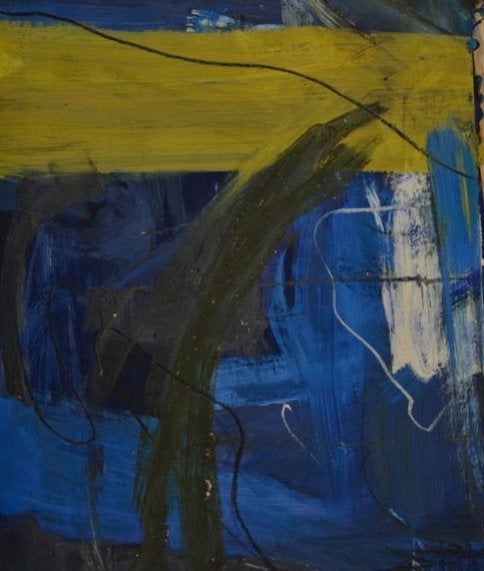Unwrapping the paintings for our "Abstraction" exhibition, I had a shock -- or at least a wonderful surprise. I called to my associates and said, "Wow, who of you managed to get this de Kooning 'Landscape' painting?" The answer: "We have no de Kooning 'Landscape' painting for the show. That is a Mary Abbott."
Mary Abbott, "Untitled," c.1950-1951, Oil on paper, 40x30 in.
Circa 1950-1951, Mary Abbott painted "Untitled," a vibrant, gutsy work playing off of intense layers of brush strokes across the canvas that give a visceral, landscape-like impression. De Kooning's first known stab at these structures and colors took place in the mid-50's and reached maturity in about 1957. This is somewhat unsettling, as we never think of de Kooning as being influenced by anyone other than his more well-known male counterparts! He spoke mostly of Gorky's influence, never mentioning Mary Abbott's. I decided to look some more.
Willem de Kooning, "Ruth's Zowie," 1957, Oil on canvas, 80¼x701/8 in
The story starts to unfold. This discovery is not just in a few paintings, but is in many of his works, parts of works, and so on. Mary Abbott's strong personal and professional relationship with de Kooning influenced his output to an astonishing degree. Abbott had experimented with abstract landscapes from her Southampton home for nearly five years by the time de Kooning began his own landscape series. The creative exchange between the two artists continued through the following decade. As Abbott and de Kooning's lives were intertwined, so were their works, which seem to share subject, technique and even color palette. This fundamental exchange of ideas has gone almost entirely unrecognized and provides new insights into the oeuvres of both Abbott and de Kooning.
Where Has Mary Abbott Been All These Years?
When it comes to Abstract Expressionism, the same auspicious names dominate: Pollock, de Kooning, Rothko, Motherwell, Gorky. These artists have dominated the discussions of art historians, textbooks, museum exhibitions and newspaper headlines since the late 1940s. Imagine a largely overlooked protagonist in this narrative, a crucial figure in the New York Post-war art scene whose story is only now surfacing. This new story is emerging and with it the understanding of the profound influence Mary Abbott had on the Abstract Expressionist movement and especially on her lover, Willem de Kooning.
Willem de Kooning, "Montauk Highway," 1958, Oil on canvas, 59 x 48 in
Though her story includes fascinating professional relationships with Barnett Newman, Mark Rothko and Willem de Kooning and formal study under George Grosz and Eugene Weiss, Mary Abbott's oeuvre speaks loudly for itself. Capturing abstract landscapes even before de Kooning, Abbott's experimentation in abstract-all-over composition achieved a rare level of expression. They pulse with an intimacy and vehemence which her older, male counterparts were only later able to attain. Her intuitive ability to render mood and environment in her abstract canvases demand to be seen.
Mary Abbot, "Lucy," 1951 (left) and Willem de Kooning, "Two Figures in Landscapes," 1968
Support HuffPost
Our 2024 Coverage Needs You
Your Loyalty Means The World To Us
At HuffPost, we believe that everyone needs high-quality journalism, but we understand that not everyone can afford to pay for expensive news subscriptions. That is why we are committed to providing deeply reported, carefully fact-checked news that is freely accessible to everyone.
Whether you come to HuffPost for updates on the 2024 presidential race, hard-hitting investigations into critical issues facing our country today, or trending stories that make you laugh, we appreciate you. The truth is, news costs money to produce, and we are proud that we have never put our stories behind an expensive paywall.
Would you join us to help keep our stories free for all? Your contribution of as little as $2 will go a long way.
Can't afford to donate? Support HuffPost by creating a free account and log in while you read.
As Americans head to the polls in 2024, the very future of our country is at stake. At HuffPost, we believe that a free press is critical to creating well-informed voters. That's why our journalism is free for everyone, even though other newsrooms retreat behind expensive paywalls.
Our journalists will continue to cover the twists and turns during this historic presidential election. With your help, we'll bring you hard-hitting investigations, well-researched analysis and timely takes you can't find elsewhere. Reporting in this current political climate is a responsibility we do not take lightly, and we thank you for your support.
Contribute as little as $2 to keep our news free for all.
Can't afford to donate? Support HuffPost by creating a free account and log in while you read.
Dear HuffPost Reader
Thank you for your past contribution to HuffPost. We are sincerely grateful for readers like you who help us ensure that we can keep our journalism free for everyone.
The stakes are high this year, and our 2024 coverage could use continued support. Would you consider becoming a regular HuffPost contributor?
Dear HuffPost Reader
Thank you for your past contribution to HuffPost. We are sincerely grateful for readers like you who help us ensure that we can keep our journalism free for everyone.
The stakes are high this year, and our 2024 coverage could use continued support. If circumstances have changed since you last contributed, we hope you’ll consider contributing to HuffPost once more.
Already contributed? Log in to hide these messages.
